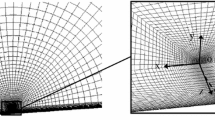Abstract
Crack trajectory studies in propellant and liner materials under combined loading conditions have been conducted using plane stress sheets. Linear strain finite element modeling was used to determine the direction of maximum principal stress, which was hypothesized as the direction of crack propagation. However, it was found experimentally that contrary to many other engineering materials, this was not the nature of the behavior of cracks in these low modulus materials. Instead it was found that in order to predict the trajectory it was necessary to model the crack with a finite tip radius which in reality was produced by the deformation of the soft materials before the crack propagated. Experimental results were accurately predicted in this manner, and it was not necessary to use nonlinear strain measures nor nonlinear constitutive laws.
Résumé
Les études de trajectoires de fissuration dans les combustibles solides et leurs matériaux de revêtement sous des conditions de sollicitations combinées ont été effectuées en utilisant des feuillards en état plan de tension. On a fait appel à un modèle d'analyse des déformations par éléments finis pour déterminer la direction de la plus grande contrainte principale, supposée être celle de la propagation de la fissuration. Toutefois, on a trouvé lors des essais que, contrairement à la plupart des autres matériaux de construction, ces matériaux à faible module ne présentent pas le même comportement en fissuration. On a trouvé en effet que, pour prédire la trajectoire de fissuration, il est nécessaire de considérer une fissure comportant un rayon d'extrémité d'entaille fini, que se produit en réalité par la déformation du matériau ductile avant la propagation de la fissure. Les résultats expérimentaux ont pu être prédits avec précision sur cette base, et il n'a pas été nécessaire de recourir à des mesures de déformations non linéaires, ni de faire usage de lois à solutions non linéaires.
Zusammenfassung
Rißlaufbahnuntersuchungen in festen Treibstoffen und in ihrem Umhüllungsmaterial unter zusammengesetzten Belastungsbedingungen wurden unter Gebrauch von ebenen Spannungsscheiben ausgeführt. Das endliche Elementenverfahren für lineare Verformung wurde zur Bestimmung der Richtung der maximalen Hauptspannung angewandt, unter der Annahme daß diese Richtung die der Rißausdehnung sei. Aber man fand experimentel daß, entgegengesetzt von anderen Baumaterialen, dies nicht die Natur des Verhaltens von Rissen in diesem Material mit niedrigen Modulus war. An Stelle fand man daß man zur Voraussagung der Rißlaufbahn ein Modell mit einem endlichen Rißspitzenradius benötigt, der in Wirklichkeit durch die Verformung des weichen Materials von der Rißfortschreitung erzeugt wird. In dieser Weise wurden Versuchsergebnisse genau vorausgesagt und man benötigt keine nichtlineare Verformungsmessungen und keine nichtlineare Aufstellungsgesetze.
Similar content being viewed by others
References
F. Erdogan and G. Sih, Journal of Basic Engineering (1963) 519.
C. A. Felippa, Refined Finite Element Analysis of Linear and Non-Linear Two Dimensional Structures, SEL Report No. 60–22, University of California, Berkeley (1966).
J. D. Malone, A Computer Program for the Analysis of Linearly Elastic Plane Stress, Plain Strain Problems, M. S. Thesis, Naval Postgraduate School, Monterey, California (1968).
A. G. Thomas, J. Polymer Science, 31 (1958) 467.
Author information
Authors and Affiliations
Rights and permissions
About this article
Cite this article
Marinshaw, S.A., Lindsey, G.H. Plane stress crack trajectories in low modulus materials. Int J Fract 11, 273–282 (1975). https://doi.org/10.1007/BF00038894
Received:
Revised:
Issue Date:
DOI: https://doi.org/10.1007/BF00038894




